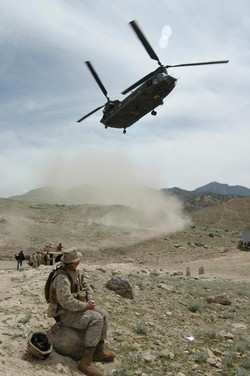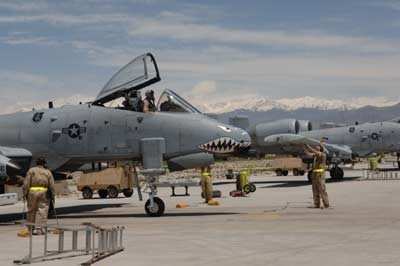Acknowledges Civilian Casualties From US Attacks
 Avoiding civilian
casualties is a high priority for US aircrews, Defense Secretary
Robert M. Gates said at Bagram Air Base in Afghanistan on
Wednesday. Gates came to Bagram to get a full picture of the
American aviation effort in Afghanistan.
Avoiding civilian
casualties is a high priority for US aircrews, Defense Secretary
Robert M. Gates said at Bagram Air Base in Afghanistan on
Wednesday. Gates came to Bagram to get a full picture of the
American aviation effort in Afghanistan.
Civilian casualties from American and NATO bombing attacks are
causing fury in parts of the embattled country. An attack on the
village of Shindand in Herat province killed at least seven
innocent bystanders and allegedly many more August 22. US Central
Command has ordered an investigation.
"We're very concerned about this; it's a high priority for us,"
Gates said. "We work at that hard, work at it harder and then take
another look to see what more we can do to limit innocent people
who are killed when we go after our enemies."
Gates spoke with F-15E Strike Eagle and A-10 Thunderbolt II
crews and maintainers who provide close-air support to ground
forces in Afghanistan. Earlier in the day, he met with Afghan
President Hamid Karzai.
"President Karzai told me this morning that the Afghan people
still very much believe we are here to help them and overcome their
enemies," Gates said. "They are still very friendly toward the
United States. The key for us on those rare occasions when we do
make a mistake -- when we do make an error -- is to apologize
quickly, compensate the victims quickly and then carry out the
investigation."
That's what coalition forces do in Iraq, and it should be the
model in Afghanistan "so that people know we do care about them and
that we have very deep regret if there is an accident," the
secretary said.
Air Force Brig. Gen. Mike Holmes, the commander of the 455th Air
Expeditionary Wing based here, released a DVD showing a typical
engagement.
A ground unit spotted a truck fleeing an area. It had what
appeared to be a launcher on it, and the truck's occupants had just
used it to fire on coalition forces. There were 10 to 15 enemy
personnel aboard the truck, in rugged terrain, at night.
Ground controllers vectored an F-15E Strike Eagle to attack the
truck. The F-15 pilot -- call sign "Dude Zero-5" -- spotted the
truck and was prepared to attack. Dude, he's going through a
village," the air ground controller radioed. "Dude Zero-5, at this
time he is passing by several compounds."
Dude acknowledged the transmission and was 15 seconds away from
dropping. "Dude, are you seeing this? All these compounds right
next to him?" the controller asked.
Even as that question was coming out, Dude radioed "Abort,
abort, abort."
"Dude Zero-5, copy: abort, abort, abort," the controller
replied.

The US personnel stopped the attack, even though it almost
surely would have killed 10 to 15 enemy fighters, rather than
possibly kill innocent people in the compounds.
The pilot and ground forces managed to keep tracking the vehicle
and finally used a guided bomb to destroy it well clear of any
houses, villages or compounds.
Army Gen. David D. McKiernan, commander of NATO's International
Security Assistance Force, addressed the issue of civilian
casualties yesterday while speaking with reporters traveling with
Gates.
"Any civilian casualty caused by NATO or American forces is
inadvertent, McKiernan said. "It's a tragic mistake. But the enemy
we fight on purpose mixes in with the population."
It is extremely difficult to avoid civilian casualties in any
counterinsurgency campaign, he said. But the Taliban and other
insurgent groups purposely puts civilians at risk.
"They purposely target civilians, and we see that with suicide
bombers, with car bombs [and] with asymmetric attacks on population
targets," McKiernan said. "I draw a huge distinction between
civilian casualties that are a result of [Operation Enduring
Freedom] or ISAF actions and those caused by the insurgency."

That said, though, the general reaffirmed that every effort is
made to avoid civilian casualties.
"We have reviewed our procedures for the application of lethal
force," he said. "I've just revised a tactical directive that tries
to be very measured in how we apply lethal force."
(Aero-News thanks Jim Garamone, American Forces Press
Service)
 Sierra Space Repositions Dream Chaser for First Mission
Sierra Space Repositions Dream Chaser for First Mission ANN's Daily Aero-Term (05.10.24): Takeoff Roll
ANN's Daily Aero-Term (05.10.24): Takeoff Roll Aero-News: Quote of the Day (05.10.24)
Aero-News: Quote of the Day (05.10.24) Aero-News: Quote of the Day (05.11.24)
Aero-News: Quote of the Day (05.11.24) ANN's Daily Aero-Term (05.11.24): IDENT Feature
ANN's Daily Aero-Term (05.11.24): IDENT Feature





